Figure 10.1 EPA Regulation Summary
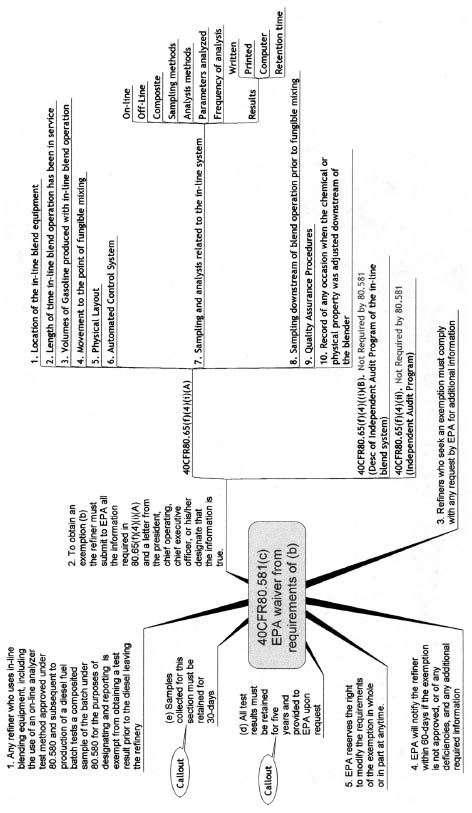
In this chapter, you will be encouraged to develop your own style of maps and read about some amazing applications covering the following topics:
The intention of the laws of idea mapping (refer to Chapter 3) is to maximize recall and thought organization, to clearly define associations, to provide opportunities for generating greater quantities of ideas, and to leverage both left and right cortical skills. I recommend following the laws as closely as possible during the early stages of learning, but the intention is not to limit ingenuity. At some point you will have an application where breaking the rules actually provides greater creativity and fulfillment of purpose. Making a conscious choice to do this is part of learning to master some of he more advanced idea-mapping skills. In this chapter, each map example will break some of the rules—or maybe I should say that the creators have taken some artistic liberties. This is intentional. After all, this tool is for you, the author of your map. I encourage you to work and create in a way that will give you pleasure and meet the needs of your application. Have fun with it!
The idea maps in this chapter are also available in color at www.IdeaMappingSuccess.com.
This example uses the Mindjet software. The application did not lend itself to the “one word per line” rule. Michael Torpey works on the Diesel Blending Project SPA (Single Point of Accountability), at one of the world’s largest energy companies. Refer to Figure 10.1 as he describes this application.
Figure 10.1 EPA Regulation Summary

Torpey shares,
I am working on a project that will require EPA (Environmental Protection Agency) approval. Two people familiar with the EPA requirements for the project provided me with two contradictory opinions about one of these requirements. I had read the EPA regulation several times, but I was not able to determine who was right, and the format of the published regulation made it difficult to follow. Although it is written in outline form, with numbers and letters separating the various sections, it was written without indentations, which would help to show where one section ends and another begins. I began to summarize the regulation by hand, but decided to use an idea map instead. When the idea map was complete, it proved to be useful for several reasons:
Megan Clark has held numerous leadership positions within a large automotive company in Michigan. Her expertise is broad and ranges from information technology to organizational development. Her current title is Manager, Program Management Office, Information Technology. She is one of those unique individuals who are both highly technical and highly creative. I met her in 1998 when she brought me into her organization to teach a 2-day workshop. When Megan finds something worthwhile, everyone wants to participate. Because of that class and its success, over 600 employees of this company have attended my workshops to date.
Shortly after attending this class, Megan was at a high-level leadership meeting. During one of the breaks, a prominent member of the management team approached her and said, “Megan, you remind me of a book I just read.” Megan was flattered that this man would offer such a compliment. She followed up by asking, “Really? What’s the title of the book?” The executive replied, “Orbiting the Giant Hairball.”
Her reaction went from thinking she received a great compliment to wondering if she had a corporate future! The conversation was brief and then the meeting reconvened. The only thought in her mind at that point was, “Oh my, what kind of book is that?”
She immediately headed to the bookstore to get a copy of Orbiting the Giant Hairball by Gordon MacKenzie. It is a fascinating book written by a former vice president of Hallmark. Thankfully for Megan, the comment from the executive turned out to be quite a compliment.
Megan decided to map the contents of the book as she read. Refer to Figure 10.2 for her map. This is one of those books where boiling down a phrase into a single key word for the map just kills the power of the message. She took some artistic liberties and created an amazing summary of this book. Following are Megan’s thoughts about her idea map.
Figure 10.2 Orbiting the Giant Hairball
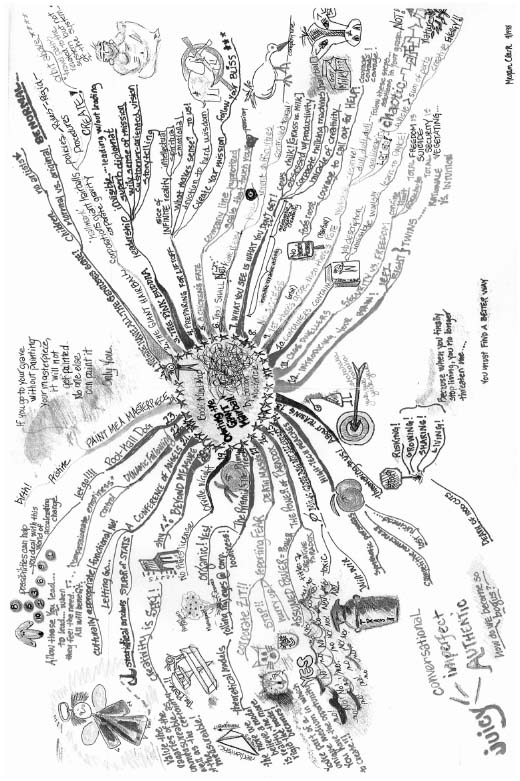
Have you ever read a book that touched you deeply and you wanted to remember every story in it? That was my experience with Gordon MacKenzie’s Orbiting the Giant Hair-ball.The purpose of creating my idea map was very personal—to help me remember the treasured stories written by Mr. MacKenzie as a way to remind myself that corporate life (yes, even in big, dreary, corporate buildings!) can have meaning and creativity for those of us within the walls!
But the story doesn’t end there. After completing the map, one of her peers challenged her to send a copy of the map to the author of the book. So she called the phone number in the back of the book to find the address where she could send her map. The voice on the other end of the phone answered, “Gordon MacKenzie.” Megan was momentarily speechless because she was not expecting Gordon to answer the phone. Eventually she sent him her map, and he was appreciative of the way Megan was able to capture his message in a visual format.
Megan also refers to this map as a teaching/mentoring tool. During one of the more recent workshops I taught for Megan’s organization, there was a participant in the group who was visually impaired. A medical condition made him legally blind at an early age. He had the most incredibly positive attitude. When Megan asked him why he was always smiling, his response was, “Because I remember seeing at a very young age, for me the grass is always green and the sky is always blue.” Prior to him leaving the automotive industry, Megan spent several weeks reading Orbiting the Giant Hair-ball to this young man. She cried while reading him the last chapter. Who was impacting whom? I think it was mutual.
The next map—which can be found in Figure 10.3—combines the use of the software with real-time mapping. Sandy Dietrich is a production superintendent working for a large automotive supplier and has been using idea maps since 1998. Following is the description of her application.
Figure 10.3 Article Summary
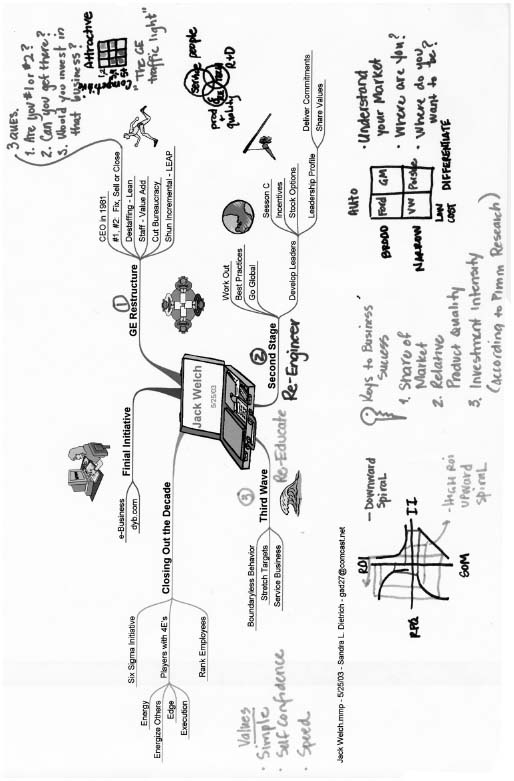
The original map was created using the Mindjet software. It was the summary of an article entitled, “Jack Welch.” The article was distributed in preparation for a company-sponsored leadership development program. I took the map of this article to the program. The map already captured most of the presenter’s material; therefore, it minimized the note taking during the lecture. Instead of worrying about taking notes during the lecture, I could focus on the presenter’s ideas.
The combination of software and real-time note taking saved time. Prior to the lecture, I already had most of the key points in my mind. The presentation reinforced those thoughts instead of introducing them for the first time. This added to my ability to remember important ideas. Instead of pages of notes, the completed map provides an excellent one-page reference with all concepts and the entire theme readily viewable. After the program I displayed it in my office, where it generated interest and conversation.
Choon Boo Lim has served in various senior management positions and is currently a principal lecturer for Ngee Ann Polytechnic in Singapore. He has been mapping since 1996, and he has mastered the advanced skill of capturing data at the moment it is presented. For suggestions on how to create “real-time” maps, see the description in Chapter 12.
Choon Boo attended a Landmark Forum seminar on March 29, 2005, in SPRING.Singapore’s Auditorium. (See his idea map in Figure 10.4.) Following is his description of that event and his map:
Figure 10.4 Landmark
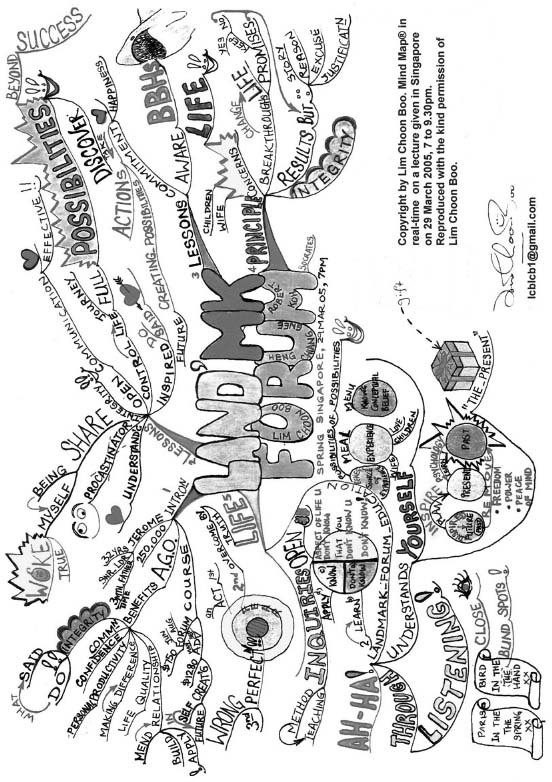
My good friend, Robert Koh, invited me to this seminar and I decided to accept his invitation. I was not disappointed.
Why did I decide to do an idea map of this session?
In the back of my mind, I was thinking, since I am already at the seminar, it would not cost me anything except listening, drawing some images, and writing down some key words. If the map turns out to be presentable, I would then be able to share it with Robert and anyone interested in this wonderful whole-brain method of taking notes.
Fortunately, the idea map turned out to be really memorable. It provided me with lots of inspirations from the many Landmark Forum graduates, who spoke with tremendous feelings and energy about what they have gained from the course. These comments were captured under the “LESSONS” branches. Of course, needless to say, the speaker, Mr. Jerome, did a wonderful job in explaining the principles involved in the course as well as what many of us have gone through in life. I captured that information under the “PRINCIPLES” and “LIFE” branches. I was extremely delighted to have mapped the lecture in real-time.
How did I create the map?
My basic preparation involved bringing along my multi-colored pens, an A4 or A5-sized paper (depending on the type of course or seminar), and arriving early for the presentation so that I could find a good seating location. The latter is important as it helps me see the face of the speaker and clearly hear the emphsis [sic] of the words. I was amazed at how the map unfolded during that seminar.
How many hours of information?
The Landmark Forum map summarised a total of about 2½ hours of presentation (7:00 PM to 9:30 PM). The break provided a great time for the brain to integrate essential information after listening and summarising the key points of the lecture as well as participants’ presentations.
How did it benefit me and how did I use it afterwards? Mapping the lecture benefited me in many ways. I find myself reviewing the lecture from time to time. In particular, the information on the “PAST,” “PRESENT,” and “FUTURE” branches helps me in finding freedom, power, and peace of mind. This seminar also taught me a lot about “THE PRESENT”—a gift that every one of us should treasure.
A more important benefit arising from my idea map was that I was able to share the knowledge of what I have gained with my many colleagues and friends. On a broader perspective, the idea map helps increase not only an individual’s intellectual capital, but also that of an organisation—especially if everyone maps any talk, seminar, or course that they attend.
Last, but not least, the idea map enables me to share my passion and dreams of encouraging everyone [to] learn this wonderful technique.
Choon Boo’s map is the original one he created. I don’t want anyone to think that he went home and made it beautiful! He has quite a gift for capturing live information. You can view one of his more complicated “real-time” maps at www.Idea MappingSuccess.com. Look for his Robert Kaplan map.
I met Michael Shaw in October of 2005. He was a participant in my workshop at Mayo Clinic in Rochester, Minnesota. He is currently a second-line manager with responsibility for three computer data centers.
My work at Mayo is unique. The original management team that brought the workshops to Mayo beginning in 2004 requested advanced training and the addition of memory and speed-reading. It requires additional work on the part of those attending to make this possible. As prework for the 2-day workshop, each participant reads a book about idea mapping and then creates a map that I review prior to class. The night before this particular series of classes, I was browsing through the maps when Michael’s map caused me to stop and study his work in detail. I felt like he had given me a personal look into his life. His map covers his past as well as his future (see Figures 10.5 and 10.6 for before and after photographs). Because nearly everything in his idea map is an image, it takes some explanation in order for you to understand the map. See Figure 10.7 following his story.
Figure 10.5 “Before” photo
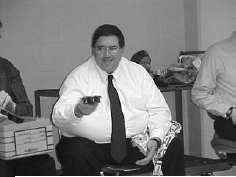
Figure 10.6 Current photo
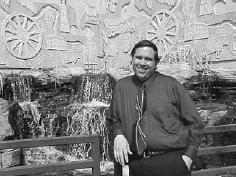
Figure 10.7 The Future
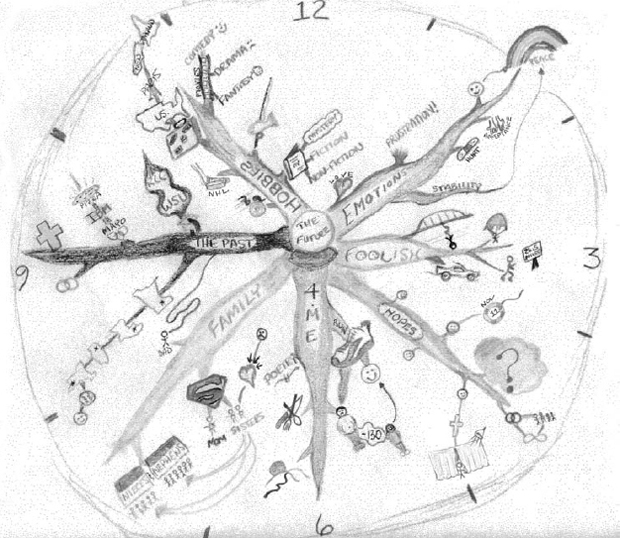
When thinking about the topic to choose for my first idea map, my first instinct was to keep it strictly business. After all, the course would be full of people from our organization of employment. However, because I had gone through two major life changes in the past 3 years, it seemed appropriate to make it personal (The Future inside a crystal ball). This proved to be a good decision as the effect was therapeutic as I drew, and became something I now call my “visual journal.”
For reasons that will become clearer after describing the “4 Me” branch, hobbies often seem foreign to me—which is why I wrote the root word backwards. This is most likely due to the fact that the majority of my time is spent alone (although I wish it were otherwise). Also it seems foreign because most of my life had been about work. I really didn’t allow myself to “waste” time on hobbies.
I was an avid reader all the way from childhood until just a couple years ago (I even read technical manuals and enjoyed them!). Since then reading has been much more difficult in that it doesn’t hold my attention. In fact, there have been several times where I can only read a couple sentences on page one and go no further. However, I still do manage to find a couple books a month that I can stick with.
I have a very wide taste in music (CD with musical notes)—classical, blues, rock, reggae, even some country—anything but opera!
I took up fishing this year. Beyond catching bass and trout locally, I took my first trip into Canada this past Labor Day. In addition to catching walleye and northern, I also kayaked (for the first time) around the island our cabins were on.
I own several hundred movies on DVD. Surprisingly, I’ve never tired of watching the same movie numerous times.
Growing up I had always wanted to go to a professional sports event. I recently attended a Minnesota Wild NHL game (an awesome experience!) as well as a Minnesota Vikings NFL game.
When I came to work for my current employer, I was given opportunities to travel. Often, this coincides with my giving a presentation on my profession—computer data center management. I’ve traveled to Orlando, Palm Springs, Seattle, Nashville, and Las Vegas. One day I hope to travel to Europe and New Zealand. Although I never followed through on it, this hope stems from the foreign languages I’ve learned in high school, college, and a previous employer: Spanish, German, French, and Japanese.
Unarguably, this was the toughest branch for me to draw. I was raised to always achieve something greater than I’d already accomplished, don’t settle for second best, and so on. Yet there are some things from my past I have a difficult time accepting.
On the good side, I have an Associate’s degree (that’s supposed to be a blue graduation cap) from Rochester Community College (RCC) and a Bachelor’s degree in Computer Science from Winona State University (WSU). I completed my Bachelor’s while I was working full time for my second employer.
My first job was delivering pizza for Domino’s. We ate pizza for dinner every night and to this day, I cannot stand the smell of it. I then left to start work at International Business Machines here in Rochester. I worked there 11 years, starting out in disk-drive manufacturing and ending up a programmer, coding tools to help build the AS/400 operating system.
I left IBM and came to work at the Mayo Clinic, also in Rochester. I’ve been here for 9 years, starting out as an off-shift computer operator and currently I am a second-line manager.
Although I show a cross on the past branch, that doesn’t mean my faith is not important to me today—it’s just that I used to be heavily involved in church (teaching Sunday School as well as being a church administrator and treasurer for more than a decade).
My greatest failure was my marriage (two rings). I’ve been involved in a divorce that has been going on for 2 years now. As I’ve told others, this isn’t something I would wish on my worst enemy. As I’ll note later, my family views me as the stable one—the one who never changes and makes all the right and moral decisions. This major life event has me on a rollercoaster [ sic] of emotion—one that I can’t get off of because it seems that this will keep going on forever.
Working backwards on the “state” branch, I’ve lived in Rochester, Minnesota, for my adult life. I attended high school in Spring Valley, Minnesota, which is only 20 minutes from Rochester. I did spend some time with my mother in New Orleans (junior in high school). This hurricane season has hit home for me [not only] in seeing the pictures, but also not hearing yet from two cousins. My family spent 1 year in Chicago; however, most of my childhood was spent in Ellington, New York (born in New York as well). Although Ellington is a very small town, it supported the town kids in sports enthusiastically. My favorite was baseball. As a catcher, my goal was to make the traveling team (baseball and smiley face)—which did happen.
My father is connected to two branches—Family and The Past. When I turned 16, my parents divorced. It was at that time that he told me that he never wanted a son at all and wished I had not been born. I wasn’t upset mainly because he had not spent much time with me growing up, so it’s hard to know what you’re missing when you didn’t have it to begin with. Now that he is getting older and his health is deteriorating, he is making attempts to talk with me—I’m just not sure if I want to yet. There is a lot of distance (winding black branch) that I’m not sure can be overcome.
When my father left us, my mother told me I needed to get a job and help her support my two sisters. My sisters are twins and they are 5 years younger than I. Although I was too young to see it at the time, I became the “man of the house,” and having to assume so much responsibility so young (I was paying the majority of the bills), I ended up becoming like a superhero (the Superman logo). Ironically, I would later come to shun this stereotype and persona—for I was held on a pedestal others would not let me come down from. It took my standing up and adamantly stating that I didn’t have all the answers and that I am just as human as anyone else, before they saw that I had changed and would no longer “play the part.”
Unfortunately, one of my sisters suffered a heart attack this past year. She came through it okay, but events such as this make one seriously look at their own life, family, health, and even the words we say (or don’t) to others.
I have several nieces and nephews that I care for deeply and wish we could be closer.
Three years ago I went through a mid-life crisis (my second life event). I describe my experience as:
One day I woke up and everything I liked to do, such as reading, my job, watching sports, etc., etc—I didn’t like anymore. I felt foreign. So I got on a treadmill. This also coincided with my mother having a heart attack. I was extremely overweight and when I went in to have myself checked out, in a span of 4 hours I had gone from seeing my family doctor to a top heart specialist at Mayo. Given my health and lifestyle, he gave me 5 years to live. In the course of a year from the time I got on the treadmill, I lost 130 pounds (running shoe, me before and after). Call it anger, angst, or even rage—that was my motivation. I ran from 2–5 miles a day, every day. Above are a couple of before and after pictures.
It’s funny to me that although I’ve always been a “Type A” personality, I now often find myself sitting on my balcony watching sunsets (the road leading to the hills with the sun setting behind). The simple things in life seem to appeal to me more than ever before.
Although it led to my weight gain earlier in life, I found I had a knack for cooking (fork, spoon, and knife). Although it may have to wait until I retire, I would like to attend a chef-training school to see how far I could take that skill.
Finally, although I could have put it under hobbies, I do on occasion write some poetry—it helps me to collect my thoughts. I put it here because there are very few people I would show this to, so for the most part it really is just “4 Me.”
My hopes are all about the future and most are unknown (the question mark in the cloud). I included lots of smiley faces as I wish for the best.
I do want to be in a relationship sometime in the future (two more rings). I also hope to have a family and that it will last forever (infinity symbol).
These past 2 years I’ve been searching again for the meaning of my life. There have been many, many days I question what good I am. Ironically, in November 2004, I got an answer for at least 1 day. I was in my office wondering this very question when my door burst open. One of my administrative assistants ran in with her arms waving and unable to talk—I didn’t have a clue at first of what was happening. She had enough sense to spin around and put my hand in front of her stomach—she was choking on a piece of food. I almost had someone die in my arms that day. After four tries, she started to slump forward in my arms. On the fifth try, I thought for sure I was going to hurt her, but fortunately it was on that final try that the food dislodged and she took a gasp of air. Although we don’t talk about it much, we have a bond that can never be broken. That was Veteran’s Day (November 11—life preserver). Although it was a very good thing, I can see where I tend to erase the positive, focus more on what I could/should be doing, and then become down as I try to jumpstart myself once more to other things.
I do attend church again but, for the most part, stay on the fringe (smaller cross). Although I want to take things more slowly than in the past, I was asked to play a role in a drama in the near future (me on stage).
Every once in a while I tend to do something crazy (e.g., driving a car at 150 mph). Most of these I haven’t done yet as my family members try to talk me out of them—maybe it’s a good thing they do. I’ve threatened to go bungee jumping off a bridge or go parachuting quite often. I am thinking of training for a marathon. This past July I ran my first 5k race. All of the proceeds went to one of my coworkers who has been battling brain cancer for the past 10 months. His initial prognosis was 18 months to live and when I crossed the finish line, he met me there. I whispered to him that I would run that race every year if he would continue to meet me at the finish line. He is one of my heroes.
Most of my life I’ve kept my emotions buried (part of my upbringing). The branch is primarily red and it actually turned into a vein which burst open when I thought of all the frustration I’ve experienced by not letting my feelings (like love) show. The stability branch is in gold, as it is what several seem to prize the most in life. That branch leads to peace (the rainbow). However, most people (including me) are unable to take the easy path, so they have to go through hurt (bandage) and come to a point of acceptance (open hands) before they can be happy and hopefully peaceful.
After I had drawn all of this, I somehow felt that my future had boundaries or limitations and yet I didn’t know how to show that. Then I got the idea for the clock. When I consider that I am over 40, I realize that I can still do much in life but it is an eventual march against time. Finally, although I had no clue I had done this when I drew the clock, I found it interesting that “peace falls outside time.” There is a lesson in there somewhere.
Kaizad Irani is an architect who left the corporate world because of his passion to teach—and he is one of the best at it! Kaizad is currently a professor of landscape architecture with Parkland College in Champaign, Illinois. He is a sought-after guest professor by universities all over the world. I count it a privilege to know him. Below is the story about his map. Refer to Figure 10.8.
Figure 10.8 World Trade Center Memorial Park
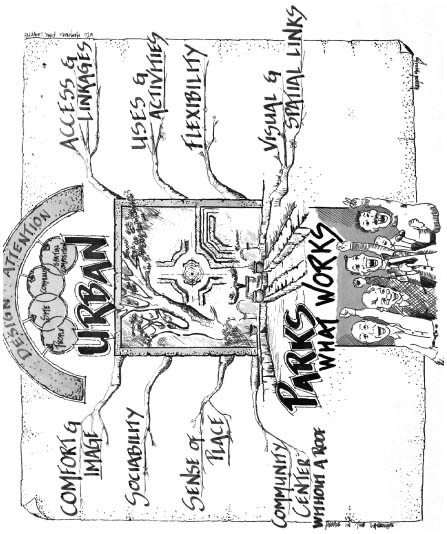
Two years after the tragic events of September 11, 2001, the city of New York started looking at various memorials to help the residents and the world heal from the aftermath of devastation. They contacted the Associated Landscape Contractors of America (ALCA), and initiated a design competition to create a landscape design for a memorial park that would be built in Lower Manhattan under the shadow of Ground Zero.
In May, 2003, the finalists (including myself) for the design charrette met in Chicago and started working on the landscape plan. The design charrette consisted of approximately 30 finalists who were some of the top landscape architects and designers in the country. Each architect was assigned to one of five teams, and the teams were given 2 days to come up with a landscape plan for the WTC (World Trade Center) Memorial Park. I created this map for my team during the initial Site Analysis phase of the design process.
The map that I created helped explain to the design jury the significance and importance of designing the winning project. It showed what makes an urban park work. This was a key aspect to our success.
Currently, the project [is] undergoing some final changes and logistical issues before its installation in New York.
As you can see from these examples, idea mapping isn’t about a bunch of rules. It’s a process of understanding how it is that our brains associate, collect, organize, and remember information and then of deciding on the best way to represent and use that data in a meaningful way. See Figure 10.9 for a summary of the different idea maps where we saw how the rules were broken in this chapter. Create maps that fulfill your purposes and create them in a way that is visually pleasing. At the same time, feel free to create idea maps that look like a complete disaster. I know I’ve certainly had my share of those, but they were only for me and no one else. Be yourself when you are idea mapping. After all—they are your ideas!
Figure 10.9 Chapter 9 Summary
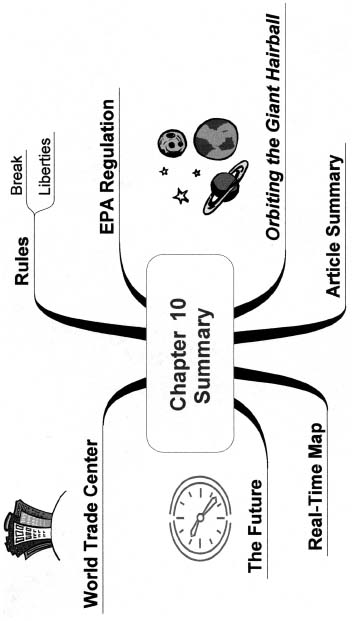
In the next chapter we will revisit one of your earlier activities and see how you are progressing.